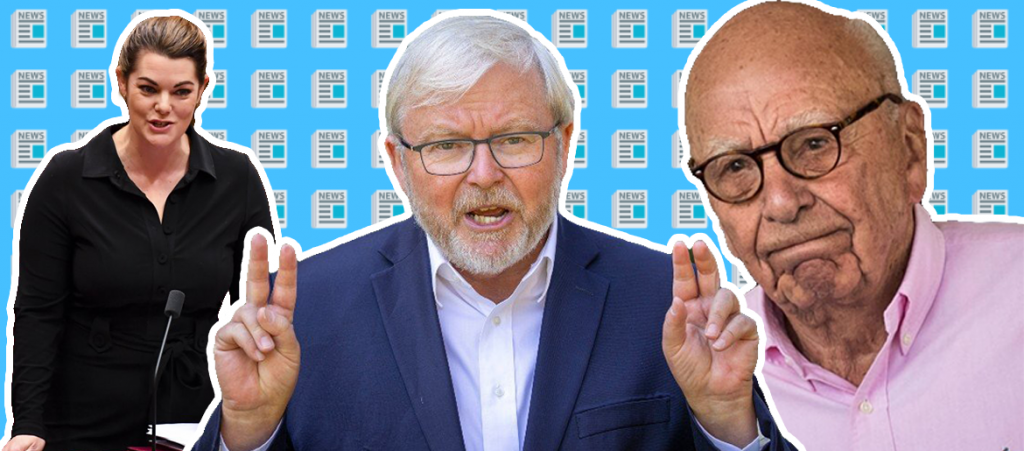
Remember Kevin Rudd’s petition for a Royal Commission into the power of Murdoch media? The Senate inquiry tasked with investigating media diversity (and all the problems that come with it) jas finally handed down its report. Here’s how the whole thing worked, what recommendations were made, and what’s going to happen next.
Summarised in one sentence: The report confirms it is the government’s responsibility to ensure Australia has a healthy, diverse media landscape… but they are very unlikely to do anything about it.
Quick recap: Senate Inquiry into Media Diversity
Way back in October 2020, former Prime Minister Kevin Rudd launched a petition calling for a Royal Commission into media diversity in Australia – especially the almost-monopoly of Rupert Murdoch’s News Corp. The petition achieved a record-breaking 500,000+ signatures.
Off the back of this, the Senate supported Greens Senator Sarah Hanson-Young’s motion to establish an inquiry to look into the issue of media diversity, independence and the effect of concentrated ownership on Australian democracy – you can read the full list of terms that the inquiry was looking into here. Hanson-Young led the committee conducting the inquiry which began in March 2021.
They called for submissions from Australian news publishers, then conducted public hearings which have taken place throughout 2021. The hearings saw testimony from figures, including:
- Former PMs Rudd and Malcolm Turnbull
- Big wigs from News Corp, including chairman Michael Miller and Sky News CEO Paul Whittaker, and Nine Entertainment (chairman Hugh Marks)
- Editors and publishers from Guardian Australia, Crikey, The Conversation and The New Daily
- Senior figures and policy representatives from Google and Facebook (now Meta)
- Representatives from media reporting and regulatory bodies, like ACMA and the ACCC
What does the Senate Inquiry Media Diversity report say?
The final reporting date was extended a few times during the year, and was finally delivered on 9 December. You can read the full report here, but here’s our summary of the key points:
- Regulation: The existing bodies are not doing a good enough job of regulating the media landscape. It’s largely because each type of content has a different regulator – TV, radio, print are not checked by one single body, leaving a lot of gaps. There is no mandatory reporting body for digital media.
Because of this, media outlets and tech platforms (Google and Facebook/Meta) have been left to self-regulate – not a good thing. It has led to situations like Sky News being banned from YouTube. That situation could have been avoided if a regulator with real power was enforcing rules that protect the standard of information being published in Australia. - Media Ownership: The report found that the shift to digital publishing, and the power of Google and Facebook as distributors of news, has made Australia’s media concentration worse. Despite seeming to increase news access, by taking advertising revenue away from publishers it only allows the biggest, richest outlets survive – reducing the competitiveness and stability of small and regional outlets. The committee determined that the Federal Government should be responsible for levelling the playing field.
The media diversity report made the following recommendations:
- Establish a judicial inquiry into the existing media regulation framework and media monopolies. The inquiry would largely focus on the creation of single, independent news regulator to oversee all publishers and formats. This is the biggest recommendation.
- Guarantee continued, long-term funding for the ABC, SBS and AAP
- Keep the NBN as a public asset, and secure enough funding so Australia’s internet actually works how it should
- Establish a public trust fund for emerging news outlets, especially in regional areas
Reminder: What’s a judicial inquiry?
A judicial inquiry is an independent investigation conducted on behalf of the government, but not by the government. Instead, it is conducted by a current or former judge. Judicial inquiries have powers similar to a legal trial or Royal Commission, in that the judge can summon witnesses to testify or seize documents as evidence. At the end of the inquiry, the judge delivers a public report that makes specific recommendations for what changes should be made – the Government does not have to act on any of the recommendations, though (but they should).
We’ve got another article that explains the different types of inquiries.
What happens now?
The Government is required to respond to the final report within six months… but the 2022 federal election will happen before then, so the decisions could be made by a completely different government.
Here’s how each party feels about it so far:
- The Labor and Greens Senators on the committee support the judicial inquiry, but…
- Labor’s Shadow Communications Minister, Michelle Rowland said the ALP would not make it an election promise
- Liberal Senator Andrew Bragg, who was the Deputy Chair of the Senate Committee, was really mad about the idea of further investigation saying that it would “endanger democracy”. It’s unclear whether this is just his opinion, or the official Liberal party POV
- Nationals Senator Sam McMahon, another committee member, is also against the idea of a judicial inquiry. It’s unclear whether this is just her opinion, or the official National party POV
A new non-profit organisation, Australians for a Murdoch Royal Commission (AFMRC), has been set up to keep the public momentum going. But without full support from at least one of the major parties, it’s unlikely an inquiry will happen. So we went through all of this for… maybe nothing? Dunno, we’ll have to wait and see.





Comments are closed.